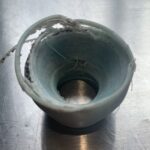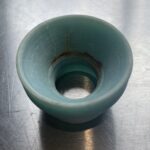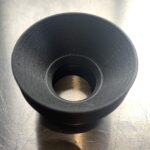A 3D print worth £38 million ?!?
Sounds fanciful doesn’t it ? But we’re not talking about the cost to print. This is the economic impact that a single spare part can have on a business ecosystem that is reliant on critical infrastructure.
Here’s the story….
Back in 2022 our friends (and landlords) at Newlyn Pier and Harbour Comissioners asked us if we could help them, so we did.
The harbour is England’s premier port for landing fresh fish and as such it has a daily market where fishermen, wholesalers and fish merchants can do their trade in the wee hours of the morning, ready to get their goods to restaurants and shops around the UK and beyond.
In order that every boat’s catch reaches its destination in prime condition the market uses a standard sized fish box. As our local snapper, Lawrence Hartwell, documents each and every day in his harbour blog “Through The Gaps” every hake, pollock, ray, gurnard and bass bought and sold is done so within a fish box. They are the blood cells of the market.
And every day, after they have done their job, they need sterilising before they get used again.
That sterilisation is done by a room-sized machine called the box washer, which is effectively a large industrial dish washer, but made to measure about 25 years ago. At the end of each market session it takes three staff members to collect up the boxes using a fork lift truck, feed them into the box washer one at a time and unload them from once super-clean.
The problem was that since it was installed the machine supplier had ceased trading so none of the spare parts were available any more. The harbour needed a solution for a mission critical piece of equipment.
So with our local 3D print agency, 3D Print Cornwall, the critical spare parts were scanned and new replacement parts printed using our Porthcurno filament. Unfortunately that didn’t go too well. We found that the extreme heat and high chlorine content of the wash water delaminated the first attempt using a 30% fill in the form (meaning there was an air-filled void within the form)
The second iteration, with 100% fill (so a solid form rather than one with an air space within it) held together well and did its job but it was seen that it was still a bit too flexible and the parts were moving in place during the wash cycles leading to poor washer performance. You can see this in the second video below where one of the cones has shifted from its ideal position.
So a third iteration was made, this time using our OrCA® carbon fibre filled material.
The form was printed solid, from our stiffer, more heat-resistent material. And they are almost indestructible.
That 3rd generation of parts was installed in Summer 2023 and those critical components have been in place and performing flawlessly ever since
The harbour now knows it can get replacement parts at short notice using local materials, removing a critical point of failure from their operations.
So why the £38m figure ?
The value of the 16,000 tonnes of seafood that goes through the harbour is around £38 million per year. And if we wanted to really stretch the point the fishing industry is worth around £150m per year to the Cornish economy, if that estimate includes revenue from the locally sourced hospitality sector.
Without the spray cones and spacers – no box washer, no box washer – no market, no market – no fish trade, no fish trade – no local fish processing or pesci-tourism.
So that is how some recycled fishing gear helped secure a big chunk of the Cornish economy.
Or to paraphrase the famous proverb – For the want of a 3D printed spray cone the Cornish economy was lost (nearly)
If you want to try these materials as filaments visit Fillamentum or one of their affiliates.
We sell them as raw pellet form direct to businesses.


